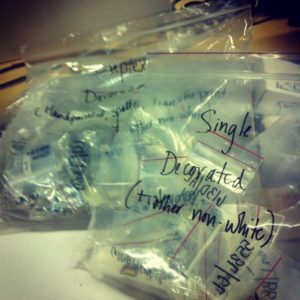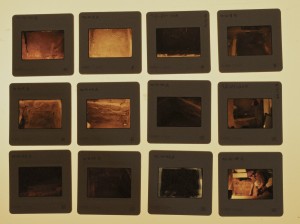Interpreting the 2020 Election: What the Results Mean for Historical Archaeology
Results of the January 9, 2021 Society for Historical Archaeology (SHA) Government Affairs Advocacy Session:…
 In 1996, former SHA Curation Committee Chair Bob Sonderman (Museum Resource Center, National Park Service) argued that archaeologists’ commitment to preserve an astounding volume of artifacts has fostered “an overwhelming sense of primal fear when the thought of deaccessioning archeological material is raised.” Archaeologists do indeed have an emotionally charged approach to collection and curation of artifacts: We value every object in an assemblage as an element in a complex historical narrative; we are especially committed to the notion that “small things” matter; and we have faith that future scholars may one day find fresh insights in old things. Yet preserving everything may be neither a practical strategy nor an especially constructive research method.
In 1996, former SHA Curation Committee Chair Bob Sonderman (Museum Resource Center, National Park Service) argued that archaeologists’ commitment to preserve an astounding volume of artifacts has fostered “an overwhelming sense of primal fear when the thought of deaccessioning archeological material is raised.” Archaeologists do indeed have an emotionally charged approach to collection and curation of artifacts: We value every object in an assemblage as an element in a complex historical narrative; we are especially committed to the notion that “small things” matter; and we have faith that future scholars may one day find fresh insights in old things. Yet preserving everything may be neither a practical strategy nor an especially constructive research method.
Historical archaeologists routinely excavate massive assemblages, and we nearly always consign them to storage awaiting the analysis of future scholars. As a result, storage spaces are overflowing in many repositories, and dwindling budgets have restricted spaces and in some cases eliminated collections managers if not whole projects. Many repositories have no especially reliable record of the materials in their possession, others cannot clearly document their ownership of holdings, and some are not remotely close to legal curation standards. Archaeologists are well-trained in excavation and material analysis, but curation and placing things in collections—much less maintaining them afterward and managing their long-term storage or even de-accession—have not occupied much of our disciplinary attention.
 On the list of fascinating archaeological research subjects, curation may not normally jump to many peoples’ minds. Collections scholars have rigorous curation, acquisition, and de-accession practices and standards, but most archaeologists have not received particularly systematic collections management training and may not comprehend the broad challenges facing archaeological collection managers. More than 30 years ago William Marquadt, Anta Modet-White, and Sandra C. Sholtz proclaimed that there was a crisis in the curation of American archaeological collections, but the oft-ignored question of archaeological curation remains awkwardly evaded today.
On the list of fascinating archaeological research subjects, curation may not normally jump to many peoples’ minds. Collections scholars have rigorous curation, acquisition, and de-accession practices and standards, but most archaeologists have not received particularly systematic collections management training and may not comprehend the broad challenges facing archaeological collection managers. More than 30 years ago William Marquadt, Anta Modet-White, and Sandra C. Sholtz proclaimed that there was a crisis in the curation of American archaeological collections, but the oft-ignored question of archaeological curation remains awkwardly evaded today.
More than a half-century of enormously productive historical archaeology fieldwork has left us with a voluminous material heritage to manage. Some long-term repositories are literally full, are unable to accommodate more collections, have decided to no longer curate archaeological assemblages, or have had their curatorial staff laid off. Increasingly more repositories charge archaeologists to store materials, but we rarely if ever include particularly concrete financial curation budgets in our project designs.
 The challenges extend throughout the world. For instance, in 2008 the Europae Archaeologiae Consilium hosted a symposium on archaeological archiving that examined dilemmas familiar to many North American historical archaeologists, including the challenges of a vast range of archaeological recording practices and curatorial standards, the need to establish digital archive standards, and management conditions that fail to satisfy the Valleta Treaty (also known as the European Convention on the Protection of the Archaeological Heritage). In Britain, the Institute for Archaeologists Council has a Special Interest Group for Archaeological Archives that aspires to develop curatorial best practices and advocate on archaeological archives issues.
The challenges extend throughout the world. For instance, in 2008 the Europae Archaeologiae Consilium hosted a symposium on archaeological archiving that examined dilemmas familiar to many North American historical archaeologists, including the challenges of a vast range of archaeological recording practices and curatorial standards, the need to establish digital archive standards, and management conditions that fail to satisfy the Valleta Treaty (also known as the European Convention on the Protection of the Archaeological Heritage). In Britain, the Institute for Archaeologists Council has a Special Interest Group for Archaeological Archives that aspires to develop curatorial best practices and advocate on archaeological archives issues.
On one level, curation dilemmas raise practical financial and methodological challenges. Narrowly defined, we minimally face a practical resource dilemma in the expense of storage, but this has methodological implications on what we actually collect in the field, de-accessioning risks taking aim disproportionately on historic artifacts, and curation policies certainly will shape the collections we leave available to subsequent scholars.
On another level, de-accession poses a particularly complex philosophical challenge to our stewardship of the archaeological past. We have implicitly linked our stewardship to saving everything, but this avoids acknowledging the state in which many collections are held, and it ignores the financial and material realities of managing such resources. Museums have long de-accessioned holdings as a normal part of collections management; that is, museums reassess their collections and permanently remove objects that are redundant, duplicates, deteriorated, or outside their mission. Library archivists likewise manage their collections by regularly reappraising collections and implementing formal de-accession policies based on factors such as infrequent use. In contrast, archaeologists have normally assumed that artifact collections are simply placed in permanent storage. Responsible scholarship demands trained curatorial professionals working in costly facilities, but most of us do not have curatorial training and are faced with less-than-ideal repository conditions. There is no absolutely objective process to decide what might one day be important to scholars, so de-accession is especially threatening to those of us who feel responsible for passing on organized and rich collections to future researchers. However, we need to recognize that de-accession is one element in broad management strategies well-developed by museums and archives faced with many of the same challenges archaeologists face.
 One final dimension of this curation crisis that remains awkwardly avoided is the lack of research that is being conducted in archaeological repositories. Esther White and Eleanor Breen’s thoughtful 2012 assessment analysis of Virginia’s archaeological repositories revealed that more than two-thirds of Virginia’s archaeological repositories are never used for research. If we are going to preserve so many collections then scholars need to use those collections and not simply view them as dead storage. The lack of more collections research may reflect an archaeological culture that grants professional prestige to scholars who conduct their own field projects. American academics administering student research, for instance, often encourage graduate students to conduct their own digs, which provides some control over their data and demonstrates their mastery of a breadth of archaeological skills. Part of the reluctance to do collections research probably also reflects our disciplinary celebration of the field experience itself and a tendency to paint “dirt archaeology” as the heart of archaeological identity.
One final dimension of this curation crisis that remains awkwardly avoided is the lack of research that is being conducted in archaeological repositories. Esther White and Eleanor Breen’s thoughtful 2012 assessment analysis of Virginia’s archaeological repositories revealed that more than two-thirds of Virginia’s archaeological repositories are never used for research. If we are going to preserve so many collections then scholars need to use those collections and not simply view them as dead storage. The lack of more collections research may reflect an archaeological culture that grants professional prestige to scholars who conduct their own field projects. American academics administering student research, for instance, often encourage graduate students to conduct their own digs, which provides some control over their data and demonstrates their mastery of a breadth of archaeological skills. Part of the reluctance to do collections research probably also reflects our disciplinary celebration of the field experience itself and a tendency to paint “dirt archaeology” as the heart of archaeological identity.
Nevertheless, perhaps the most ambitious comparative research projects can only be conducted in museum collections. Beyond the scholarly rigor such work can provide, leaving so many collections to languish means many assemblages will only be reported in technical reports. Collections research has not always been especially well-funded by granting agencies, but the cost of collections projects is often much more modest than a single field season excavation. I personally traveled to do collections research in the UK in London and York based on a relatively modest grant from my University, and that provided me the chance to work with an especially rich sample of materials I could never have hoped to find in any single excavation anywhere.
 The SHA’s goal has not been to impose codes of conduct on archaeologists and managers; rather, we simply hope to encourage responsible and informed practice and frank acknowledgement of curation challenges as part of all field archaeological research. We need to think responsibly about the final curation of the materials we excavate, and a realistic management plan should be in every research proposal. The SHA has strongly discouraged collections de-accessioning, but we may need to develop more concrete processes to confront the challenges many repositories face, and obviously many archaeologists and collections managers are wrestling with comparable issues. All of our research proposals have some statement on the collection methods and long-term storage of artifacts, but some are a bit ambiguous, and even the best-planned curation plan can be derailed by new policies. We share a common belief that every artifact has some research potential, but we need to soberly weigh the economic and practical realities of storing every object we recover into perpetuity, and we need to acknowledge that a new generation of archaeologists will eventually inherit scores of assemblages gathering dust. We face many common challenges, and we stand the best chance of developing responsible strategies if field archaeologists and collections managers share our experiences, challenges, and real and proposed solutions.
The SHA’s goal has not been to impose codes of conduct on archaeologists and managers; rather, we simply hope to encourage responsible and informed practice and frank acknowledgement of curation challenges as part of all field archaeological research. We need to think responsibly about the final curation of the materials we excavate, and a realistic management plan should be in every research proposal. The SHA has strongly discouraged collections de-accessioning, but we may need to develop more concrete processes to confront the challenges many repositories face, and obviously many archaeologists and collections managers are wrestling with comparable issues. All of our research proposals have some statement on the collection methods and long-term storage of artifacts, but some are a bit ambiguous, and even the best-planned curation plan can be derailed by new policies. We share a common belief that every artifact has some research potential, but we need to soberly weigh the economic and practical realities of storing every object we recover into perpetuity, and we need to acknowledge that a new generation of archaeologists will eventually inherit scores of assemblages gathering dust. We face many common challenges, and we stand the best chance of developing responsible strategies if field archaeologists and collections managers share our experiences, challenges, and real and proposed solutions.
All images appear courtesy Terry Brock’s flickr page
Links
Compare the materials on the January 2011 SHA Forum on Collections Management, which included a preliminary working statement on collections management.
There are numerous state and federal guidelines for Archaeological Curation Standards, which of course include the SHA Standards and Guidelines for the Curation of Archaeological Collections. The Society for American Archaeology includes links to a wide range of Archaeological Ethics Codes, Charters, and Principles.
The National Park Service inventories some standards and research on archaeological curation on their Sources of Archaeological Curation Information page.
British scholarship on these issues can be found at the Institute for Archaeologists Archaeological Archives Group and their Archaeological Archives Special Interest Group facebook page. They hold Regional Archives Workshops to promote best practices in archaeological archives management.
European standards for archaeological archives can be found at ARCHES (Archaeological Resources in Cultural Heritage: a European Standard) and on the ARCHES web page.
References
Bustard, Wendy
2000 Archaeological Curation in the 21st Century, or, making Sure the Roof Doesn’t Blow Off. CRM 5:10-15.
Childs, S. Terry
1999 Contemplating the Future: Deaccessioning Federal Archaeological Collections. Museum Anthropology 23(2):38-45.
Childs, S. Terry and Karolyn Kinsey
2003 Costs of Curating Archaeological Collections: A Study of Repository Fees in 2002 and 1997/98. Studies in Archeology and Ethnography, National Park Service.
Doylen, Michael
2001 Experiments in Deaccessioning: Archives and On-Line Auctions. The American Archivist 64(2):350-362. (subscription access)
Greene, Mark A.
2006 I’ve Deaccessioned and Lived to Tell about It: Confessions of an Unrepentant Reappraiser Archival Issues 30(1):7-22.
Patrick D. Lyons, E. Charles Adams, Jeffrey H. Altschul, C. Michael Barton, and Chris M. Roll
2006 The Archaeological Curation Crisis in Arizona: Analysis and Possible Solutions. Unpublished report prepared by the Curation Subcommittee of the Governor’s Archaeology Advisory Commission.
Marquardt, William H., Anta Montet-White and Sandra C. Scholtz
1982 Resolving the Crisis in Archaeological Collections Curation. American Antiquity 47(2):409-418. (subscription access)
Sonderman, Robert C.
1996 Primal Fear: Deaccessioning Collections. Common Ground 1(2) Special issue Collections and Curation.
Sullivan, Lynne P., and S. Terry Child
2003 Curating Archaeological Collections: From the Field to the Repository. Altamira Press, Walnut Creek, California.
Trimble, Michael K. and Eugene A. Marino
2003 Archaeological Curation: An Ethical Imperative for the Twenty-First Century. In Ethical Issues in Archaeology, edited by Larry J. Zimmerman, Karen D. Vitelli, and Julie Hollowell-Zimmer, pp.99-114. Altamira Press, Walnut Creek, California.
Weil, Stephen E., ed.
1997 A Deaccession Reader. University of Chicago Press, Chicago.
White, Esther C. and Eleanor Breen
2012 A Survey of Archaeological Repositories in Virginia. Council of Virginia Archaeologists Curation Committee.
If historic artifacts must be deaccessioned, maybe there are some opportunities for a second chance, perhaps in something like experimental archaeology. I have a particular experiment in mind that I never had the time for regarding glass bottles. Problem is: I need a lot of bottles of all different types, they need to be whole, and they will get (hopefully) destroyed in the process. Perhaps there are a suite of questions that can be answered in this way…
Hi! A common misconception about deaccessioning is that it means objects are “disposed of,” which is not the case. Deaccessioning simply means that objects are moved out of the permanent collection. Deaccessioned objects can be turned into teaching/education collections, exhibit prop collections, or rolled into destructive research projects like you are describing. If an institution cannot use the object in some way, many will try to find new homes for deaccessioned objects in more appropriate collections at other institutions. I just want to make sure you (and everyone else who reads this) understand that deaccessioning does not equal throwing objects away. Cheers!
Cheers!
I love this post so much! Thank you for saying what no one seems to understand in the field of archaeology: archaeologists are collection generators; therefore collection management should be a standard aspect of archaeological study. You spoke many truths in this post—thank you!
Archaeology is implicitly an information science; there is much that we can learn from libraries, museums, and archives (which are understood to be information centers and have, therefore, been developing methods of information management and ACCESS for decades). Yet we continue to manage archaeological collections in a vacuum… why? Another great concept we stand to learn from these information fields is that PEOPLE are at the heart of what we do… people TODAY, not ancient people! We do archaeology ultimately so that we better understand our place in the universe, not just knowledge for knowledge’s sake. The popular notion of archaeology is that “archaeologists excavate.” I feel this contributes to looting because people think that’s what archaeology is all about—obtaining relics. Archaeology is the scientific interpretation of material culture, not the scientific study of excavation! Instead of taking students into the field to generate more collections for the sake of learning field methods, take them to a repository and teach them how to curate and utilize collections. Not to say that field methods aren’t important because they are; I’m just saying that maybe we should put the emphasis where it belongs.
The biggest question is: who is supposed to do the collections management?
This article suggests archaeologists, like myself, should do more to manage what they collect. What about situations with mandatory 100% collection guidelines? Or, projects with no culling protocols? Or, projects where there is no limit on the size of historical artifacts get collected. I’ve collected tens of thousands of near microscopic glass and ceramic fragments because of adherence to near-sighted, ancient regulations. It seems like, since repositories have the option of deaccessioning, the archaeologists need to make more of an effort to help them with this process.
We are rapidly facing a situation where repositories may refuse to take historical artifacts at all. And archaeologists may start culling collections in the field at their own discretion. There is some indication this is already taking place.
The fact that, after 40 years, we’re still talking about this is even worse than the fact that we rarely, if ever, revisit these collections. What are our alternatives?